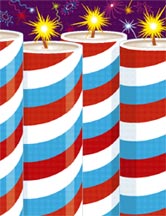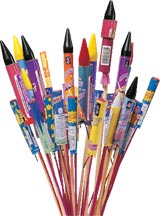Not Just for Kids
by April Falcon Doss and Lauren Silver
For over a thousand years, people have been experimenting with fireworks to make the different colors, shapes and sizes of explosions that we see in Independence Day celebrations today. They were invented in China, traveled to Europe in the 14th or 15th centuries and came to the New World with early American settlers, and are said to have been used in Independence Day celebrations in 1777.
 Fireworks Facts
Fireworks Facts
People who create and produce fireworks displays are called pyrotechnicians. For the large, public fireworks displays you’ll see on the Fourth of July, pyrotechnicians use computers to control when each fireworks shell is set off. Computers also help time detonations to music.
People who make fireworks have to wear all-cotton clothing to their underwear. That’s because nylon and other synthetic fibers create static electricity that could cause the fireworks shells to explode.
Most pets dislike the loud sounds and bright flashes made by fireworks, so keep your pets indoors and close the curtains if there’s a fireworks display nearby.
In Japan, fireworks are often shot in the daytime. The smoke effects are more important than light effects.
The Colors of Fireworks
Fireworks take their color from the chemicals used to make them.
Fireworks Have Names
Can you identify the fireworks you see in the sky? Study up and wow your friends with your newfound pyrotechnic knowledge:
- Battle in the Clouds: A number of salutes timed to explode in a series, sounding like a fusillade of musketry.
- Chrysanthemums: Stars that burst from a central core with trails.
- Diadems: Ejected cardboard-like strips or disks that flicker brightly as they fall in a cluster
- Hummers: Small tubes that spin and create a screaming or humming sound.
- Patterns: Configurations of stars that explode to create a desired shape, such as 5-pointed stars and hearts.
- Peonies: Stars that burst from a central core without trails.
- Salutes: The concussive “booms” that end most shows.
- Strobes: Clusters of flashing silvery lights that appear to float slowly to the ground.
- Tourbillons: Ignited shells that spin like a top when they rise.
- Weeping Willows: Star colors that burn and amber hue as they fall, outlining the dropping branches of the willow.
- Whistles: Noise-making tubes that dart across the sky, giving off shrieks as the shells burst.
 — courtesy of Zambelli Internationale
— courtesy of Zambelli Internationale
Careful! The thing about fireworks is that they explode. Kids especially need to be careful: almost half of the people who were injured by fireworks in the year 2000 were children under the age of 15.
Eyes, hands, head and face are most often hurt, so be sure not to hold fireworks, or light their fuses or stand too close to someone else who is setting them off. Let a grownup do that.
If you’re using any kind of fireworks at home be sure to have a bucket of water handy, in case you need to douse them quickly. To put out your sparklers, drop them, tip down, into the water bucket.
No No’s!
- Never give fireworks — even sparklers — to young children.
- Never try to re-light a firework that failed to ignite the first time.
- Never carry fireworks in your pocket.
- Never point or throw fireworks at another person.
- Never ever try to make your own!
Kids’ Calendar
Sunday, July 6
What’s Out There?
Kids ages 5-7 discover what animal life exists in the wildlife refuge by investigating clues they left behind. 1-2pm @ Patuxent Research Refuge North Tract, off Rt. 198 between Baltimore-Washington Pkwy and Rt. 32. free; rsvp: 301/497-5887 •
patuxent.fws.gov.
Monday, July 7
Firefly Fun
Kids of all ages catch and learn about fireflies w/Ranger Bob during a night walk thru the park. Meet at the River Branch Pavilion. 8:45pm @ Kinder Farm Park, Kinder Farm Park Rd., Millersville. free; rsvp: 410/222-6115 • www.kinderfarmpark.org.
Tuesday, July 8
Ancient China
Kids of all ages hear and learn about ancient China thru stories from Linda Fang by acting out characters, making sound effects and singing along. 1:30pm and 3pm @ Edgewater Public Library, 25 Stepneys Ln., Edgewater. free: 410/222-1538.
Wednesday, July 9
Grandchild Storytime
Kids ages 5 and younger learn stories thru flannel boards, finger plays and songs w/grandparents. 10am @ Calvert Public Library, 30 Duke St., Prince Frederick. free: 410/535-0291 • www.calvert.lib.md.us.
Thursday, July 10
Good Old Days Return
Kids ages 3-6 listen to poems, songs, stories and play games teaching about the days of railroading. 10-11:15am @ Chesapeake Beach Railway Museum, 4155 Mears Ave., Chesapeake Beach. free:
410-257-3892 • www.cbrm.org.


 Fireworks Facts
Fireworks Facts — courtesy of Zambelli Internationale
— courtesy of Zambelli Internationale